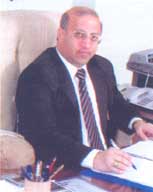|
It is a cutting edge technology that is designed
to dramatically reduce cost and time overruns
in ship-building.
Ship Electromagnetic Design Framework (Ship
EDF) is a solution that holds out vast benefits
to ship designers. And it is this and other
innovative technologies that are being pioneered
in India by Delhi-based Prime Group.
Commencing operations in 1986 as Prime Chemfert Industries (Pvt.) Ltd., which later became the flagship company and was rechristened PCI Ltd., the group has emerged as a multi-technology frontrunner. With a consistent growth of cover 50 percent over the past three years, the group,
over half of whose manpower of 475 comprises qualified engineers, caters to a wide spectrum of high-technology industries, including power and energy, electronics, precision engineering, machine tools, software and infrastructure development. Apart from Ship EDF, PCI Ltd. is a leading force in the fields of cable fault location, thermography
systems, high voltage test equipment for electrical
installations, mentions Surinder Mehta, its
founder chairman and managing director.
His enterprise operates through 22 countrywide,
two factories in Gurgaon, Haryana, and representative
offices in Nepal, Bhutan, Bangladesh and Sri
Lanka. Says Mehta, "Our focus has been on introducing,
adapting and disseminating high-technology
innovations in the Indian environment, which
enhance productivity, efficiency and cost effectiveness."
Referring to Ship EDF, Vivek Saxena, a company
director, explains that the system development
was started in 1982 by IDS S.P.A of Italy, the
firm having devised this technology for some
modules Ship EDF provides
a simulation environment for the electromagnetic
design of modern ships covering Electro-Magnetic
|
|
Computation (EMC), Radar Signature Reduction
and Control (RCS) and infra-red applications
over the full frequency spectrum. The framework
matches the requirements of the new

Mehta
says Prime's focus is to shift from generic-driven
to new-age business
generation navel units designed to reduce ship
signatures and integrating new concept combat
system equipment. It is a computer aided design
(CAD) software package that integrates in a
seamless framework, a set of electromagnetic
computation modules capable of simulating all
requisite parameters. "The product is aimed
at the shipbuilding industry, military study
centers equipment manufacturers and ship system
integration companies," says Mehta.
As the mission of the EDF solution is to provide
a design that increases the vessel's survivability
in hostile environment, its applicability is
in the naval environment. Saxena explains that
in a usual shipbuilding exercise bereft of this
technology, the vessel would be built and then
launched for trials with various sensor packages
and also for testing its signature on infrared
or EMC from the 'enemy's' point of view to evaluate
its detestability.
Requisite modifications would then be carried
out in the design to minimize this signature
so as to enhance |
|
its stealth capability,
crucial in naval warfare. "But such modifications
are really solutions of compromise once he ship
is already built, since some aspects can never
really be modified," maintains Saxena. "Besides,
all these trials took inordinately long and
modifications consumed even more time." Hence,
apart from the operational cost of the several
sailings involved, the commissioning of the
ship as an asset to the navy would also be delayed
by at least one to two years, he remarks, adding
that Ship EDF solution would circumvent this
loss.
The technology entails feeding the CAD drawing
of the ship into the Ship EDF software, which
then performs complex processing and generates
a model of the ship. This is then dovetailed
with the sensor data of the radar and infrared
and EMC characteristics that the opposition
may be using. The software is then able to simulate
the ship's signature, that is, its physical
and radar detestability by which the required
design modifications can be carried out on the
computer itself. Only a validation then needs
to be done during trials, obviating the hit
and trial approach to design. "Minor aspects
such as readjusting the angle of the funnel,
relocating a particular antenna, or repositioning
a mast or a gun mount can all contribute enormously
to the change in the radar or IR signature,"
Saxena mentions. "By doing this on the initial
CAD drawing itself, the designer is able to
accomplish an optimum design."
Each system costs Rs. 2 crore and is a one-off
installation for shipyards, particularly naval
shipyards. "To our Knowledge, there is no other
such comprehensive solution in the world," points
out Saxena, who adds that the Indian Navy and
most major navies of Europe and North America
are using these systems.
. |
SAROSH BANA |
|
|

